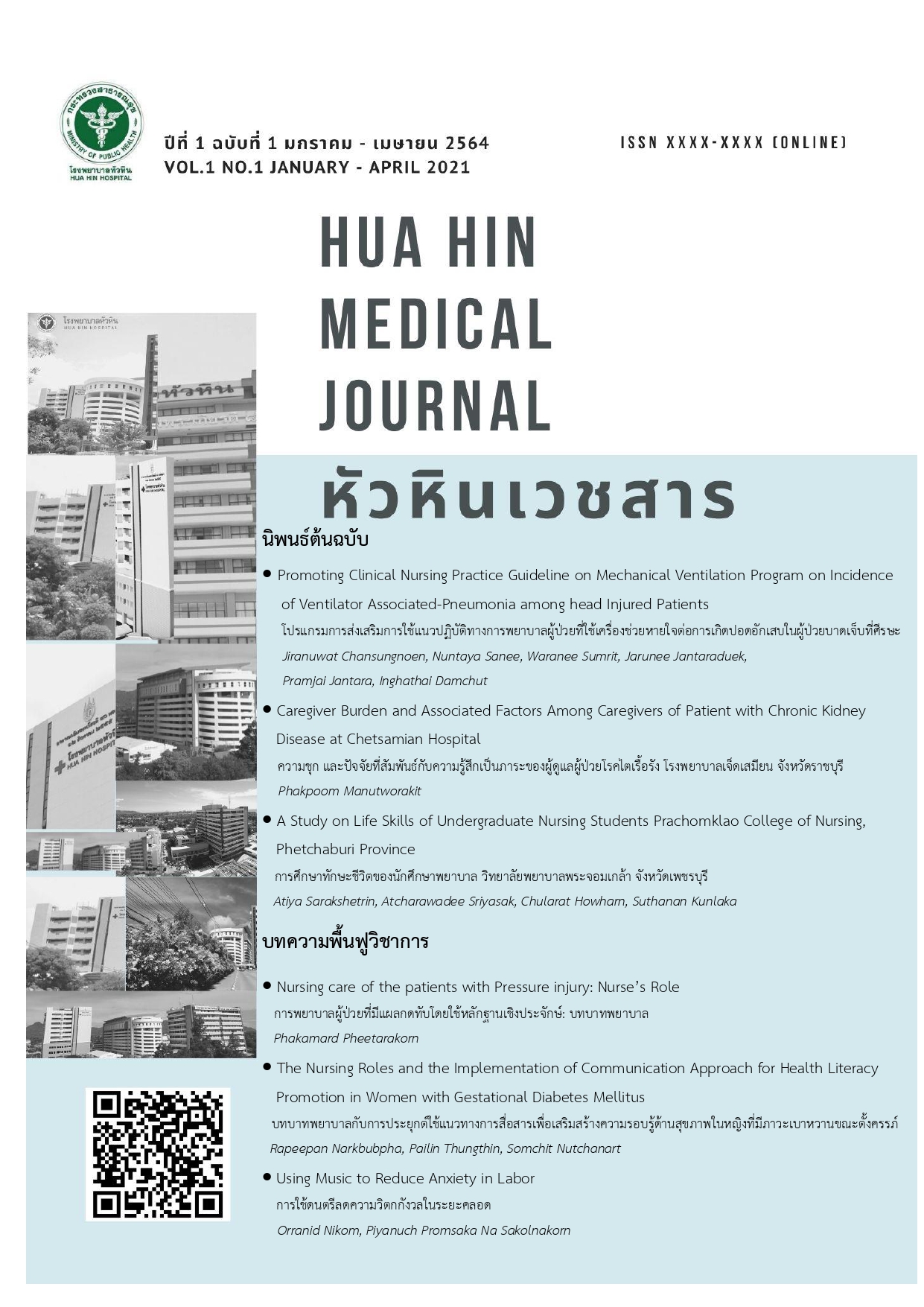Nursing care of the patients with Pressure injury : Nurse’s Role
Keywords:
Nursing care, Pressure injury, Evidence Based NursingAbstract
Pressure injury are main complication that frequently found among patients who immobile or restricted to bed from illness. Pressure ulcer has been identified as 1 of 10 indicators for measuring quality of skin care in hospital. It is the chief problem of worldwide hospital which may be complicated by infection. Although there is a clinical guideline in prevention of hospital-acquired pressure ulcers, the statistic reports high evidence of pressure ulcer on ward. This induces prolonged hospitalization and become a burden of hospitals in providing more expenditures of resource and facilities for caring those patients which increases a high treatment cost. The application of evidence-based practice in caring Pressure injury could benefit patients in reducing skin damage when compare to general nursing care. Therefore, nurse should employ appropriate pressure ulcer prevention by applying evidence-based practice in order to decrease the rate of hospital-acquired Pressure injury and reduce patients’ expenses. This article, the author would like to provide current Pressure injury evidences on definition and degrees, pressure ulcer assessment and instruments, nursing care for pressure ulcer prevention, nutritional supplementation, proper skin care, and enhancing knowledge and caring skills for care team, patients, and caregivers.
References
De O. M.et al. Pressure injury in Institutionalized Elderly People: Association of Sociodemographic and Clinical Characteristics and Risk Factors. Open Journal of Nursing. 2017; 7: 111-122.
Ahtiala, M.,Soppi, E., &Tallgren,M.Specifific risk factors for pressure ulcer development in adult critical care patients-a retrospective cohort study. European Wound Management Association [EWME] Journal. 2018; 19(1): 35-42.
Avsar, P., & Karadag, A. Effificacy and cost-effectiveness analysis of evidence-based nursing interventions to maintain tissue integrity to prevent Pressure injury and incontinence-associated dermatitis. Worldviews on Evidence-Based Nursing. 2018; 15(1): 54-61.
Whitty, J, A., McImmes, E., Bucknall, T., Webster, J., Gillespie, B. M., Banks, M., et al. The cost-effectiveness of a patient-centred pressure ulcer prevention carebundle: Findings from the INTACT cluster randomised trial. International Journal of Nursing Studies. 2017; 75: 35-42.
Etafal, W., Argaw, Z., Gemechu, E., & Melese, B. Nurses’ attitude and perceived barriers to pressure ulcer prevention. BMC Nursing. 2018; 17(14): 1-8.
Dorien D. M. et al. Knowledge of nurses and nursing assistants about pressure ulcer prevention: A survey in 16 Belgian hospitals using the PUKAT 2.0 tool. 2019
Usher, K., Woods, C., Brown, J., Power, T., Lea, J., Hutchinson, M., et al. Australian nursing students’ knowledge and attitudes towards pressure injury prevention: A cross-sectional study. International Journal of Nursing Studies. 2018; 81, 14-20.
Bergstrom, N., Horns, D., Rapp, M. P., Stern, A., Barrett, R., & Watkiss, M. Turning for ulcer reduction: A multisite randomized clinical trial in nursing homes. Journal of The American Geriatrics Society.2013; 61: 1705-1713
National Pressure Ulcer Advisory Panel, European Pressure Ulcer Advisory Panel and Pan Pacific Pressure injury Alliance. Prevention and Treatment of Pressure Ulcers: Quick Reference Guide, Retrieved September 10: 2018.
Moore ZEH, Patton D., Risk assessment tools for the prevention of Pressure injury (Review) National Pressure Ulcer Advisory Panel. National Pre13ssure Ulcer Advisory Panel (NPUAP) announces a change in terminology from pressure ulcer to pressure injury and update the stages of pressure injury. 2016; Apr13.
Fletcher J. An overview of pressure ulcer risk assessment tools. Wounds UK 2017;13:18-26.
National Pressure Ulcer Advisory Panel, European Pressure Ulcer Advisory Panel and Pan Pacific Pressure injury Alliance. Prevention and Treatment of Pressure Ulcers: Quick Reference Guide, Retrieved September 10: 2018.
กมลวรรณ เจนวิถีสุข. Basic Wound Healing and Wound Bed Preparation กระบวนการหายของแผลและหลักการรักษา. วารสารการแพทย์ศรีนครินทร์ .2557; 28(1): 10-17.
Young T. The 30 degree tilt position versus the 90 degree lateral and supine positions in reducing the incidence of non-blanching erythema in a hospital inpatient population: a randomized controlled tri-al.
J Tissue Viability. 2014; 14(3): 88–96.
พรทิพย์ สารีโส,ปิยะภร ไพรสนธิ์และ อโณทัย เฉลิมศรี. ประสิทธิผลการป้องกันการเกิดแผลกดทับของที่นอนชนิดไม่มีการเคลื่อนที่ของลมและชนิดที่มีการเคลื่อนที่ของลม : การศึกษาเบื้องต้น. วารสารสภาการพยาบาล.2559.; 31(3): 83-96.
Shi,C.,Dumville,J. C.,& Cullum, N. Support surfaces for pressure ulcer prevention: A network meta-analysis. PLOS ONE. 2018; 13(2): 1-29.
อภิญญา กุลทะเลและอัมพรพรรณ ธีราบุตร. การส่งเสริมภาวะโภชนาการในผู้ป่วยวิกฤต: บทบาทพยาบาล. วารสารพยาบาลศาสตร์และสุขภาพ.2558; 38(4): 162-171.
นงนุช หอมเนียม. บทบาทพยาบาลในการใช้หลักโภชนาการที่ส่งเสริมการหายของแผล.วารสารพยาบาลตํารวจ. 2557; 6(2): 234-249
Tonni, S., & Wali, A. Dietary considerations of wound healing in Ayurveda. J Nutr Food Sci. 2013; 3(5): 1-4.
ศิริกัญญา อุสาหพิริยกุล, ศากุล ช่างไม้และวีนัส ลีฬหกุล. ผลของโปรแกรมการดูแลผู้ป่วยสูงอายุกลุ่มเสี่ยงที่มีภาวะพึ่งพาต่อความสามารถในการลงมือปฏิบัติการดูแลเพื่อป้องกันแผลกดทับ.
สดใส สิ่งคงสิน,เณศรา สัมพันธรัตน์และศิริภา ชื่นตระกูล. ผลของการใช้โคล์ดครีมทาผิวหนังต่อการป้องกันการเกิดแผลกดทับระยะแรก ในผู้ป่วยที่ติดเตียงช่วยเหลือตัวเองไม่ได้หน่วยการพยาบาลผู้ป่วยหนัก โรงพยาบาลชลประทาน. วารสารพยาบาล. 2019; 68(4): 49-55.
จันจิรา จินาพร ,สุธิสา เต็มทับและกิตติกร นิลมานัต. เปรียบเทียบผลิตภัณฑ์ปกป้องผิวหนังที่มีส่วนผสมของปิโตรลาตัมกับผลิตภัณฑ์ปกป้องผิวหนังที่มีส่วนผสมของซิงค์ออกไซด์ต่ออุบัติการณ์และระดับความรุนแรงของการเกิดแผลผื่นแดงระยะแรกในผู้ป่วยที่มีภาวะของเสียคั่งขึ้นสมองจากตับเสื่อมที่ไม่สามารถควบคุมการขับถ่ายได้ . วารสารพยาบาลสาธารณสุข. 2561; 32(2): 59-79.
ศิริกัญญา อุสาหพิริยกุล, ศากุล ช่างไม้และวีนัส ลีฬหกุล. ผลของโปรแกรมการดูแลผู้ป่วยสูงอายุกลุ่มเสี่ยงที่มีภาวะพึ่งพาต่อความสามารถในการลงมือปฏิบัติการดูแลเพื่อป้องกันแผลกดทับ. วารสารคณะพยาบาลศาสตร์ มหาวิทยาลัยบูรพา. 2562; 27(4): 21-31.
Bergstrom, N., Horns, D., Rapp, M. P., Stern, A., Barrett, R., & Watkiss, M. Turning for ulcer reduction: A multisite randomized clinical trial in nursing homes. Journal of The American Geriatrics Society.2013; 61: 1705-1713
Downloads
Published
How to Cite
Issue
Section
License
บทความที่ได้รับการตีพิมพ์ในวารสารหัวหินเวชสาร เป็นลิขสิทธิ์ของโรงพยาบาลหัวหิน
บทความที่ลงพิมพ์ใน วารสารหัวหินเวชสาร ถือว่าเป็นความเห็นส่วนตัวของผู้เขียนคณะบรรณาธิการไม่จำเป็นต้องเห็นด้วย ผู้เขียนต้องรับผิดชอบต่อบทความของตนเอง







